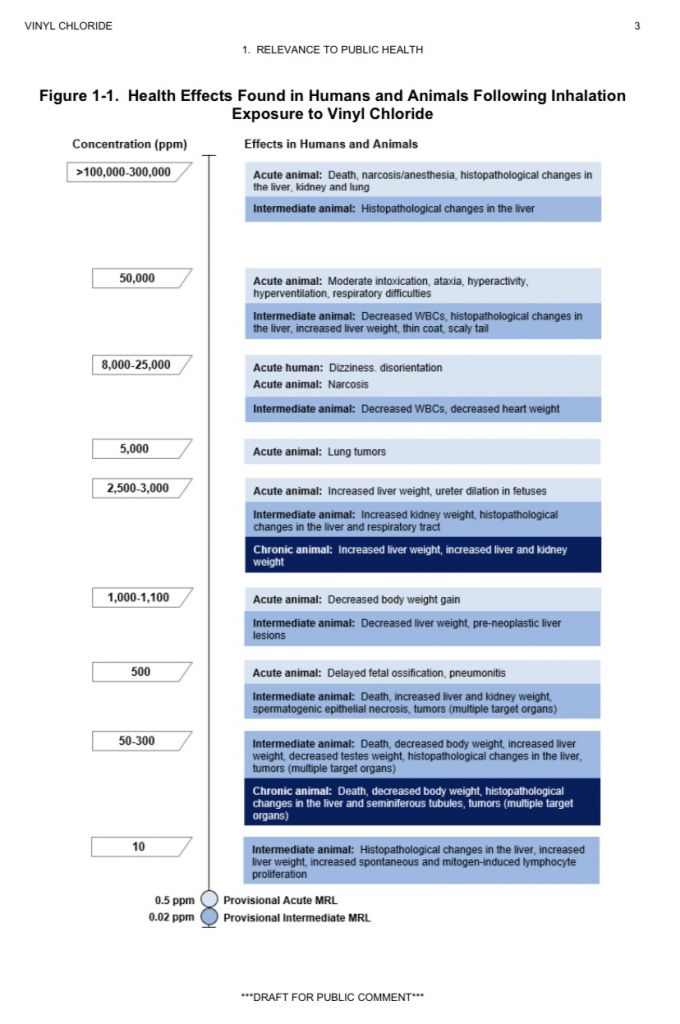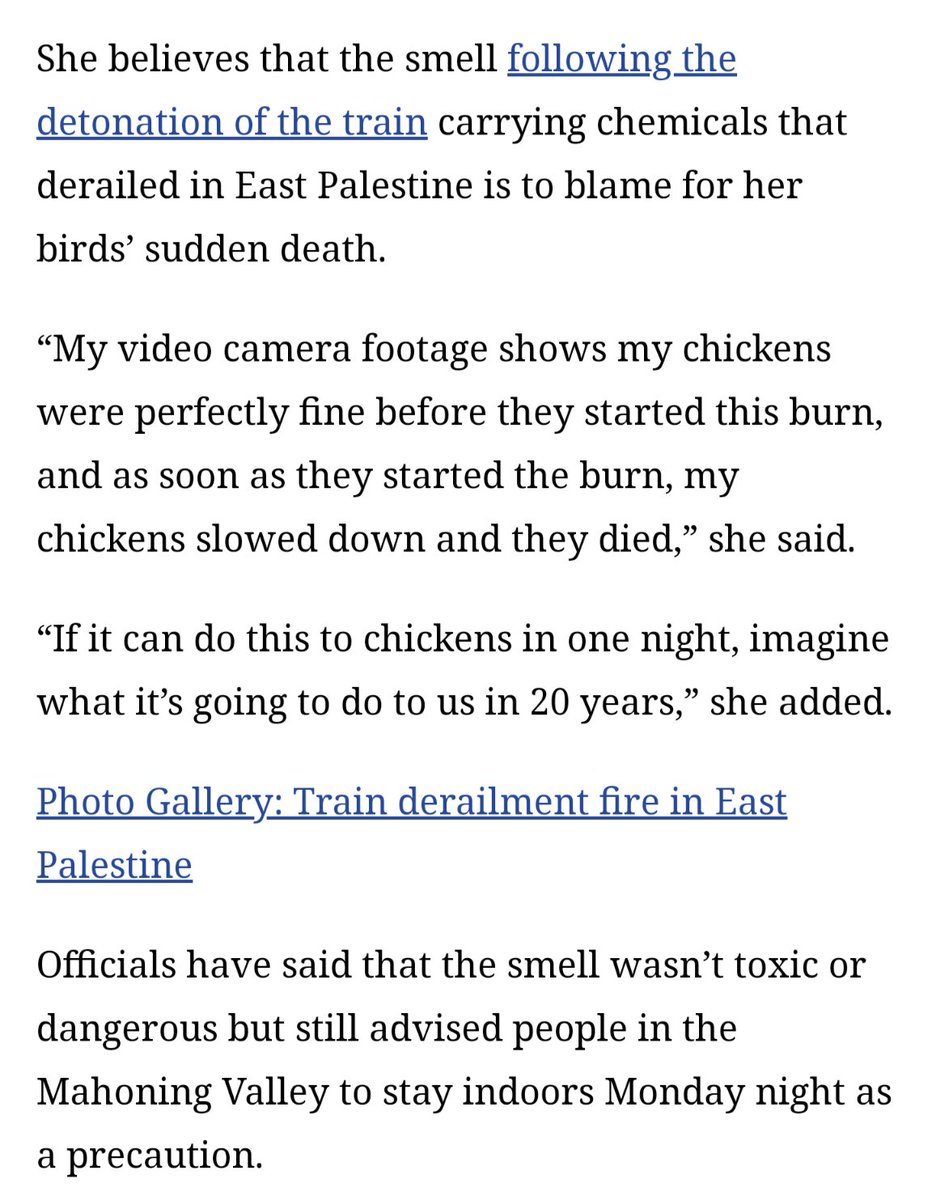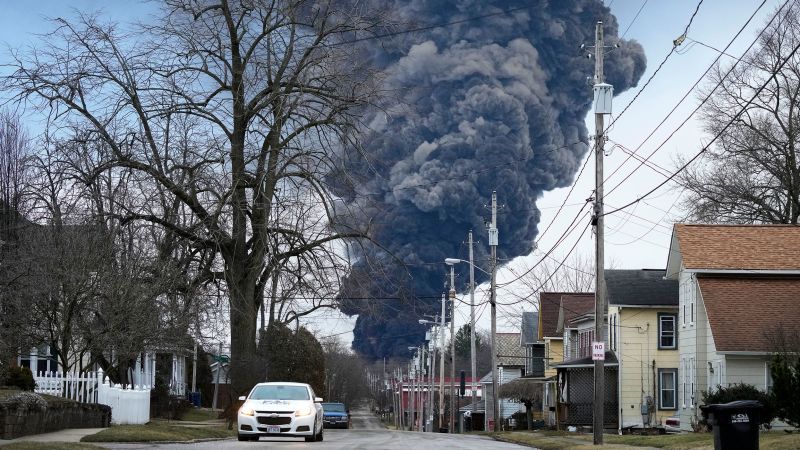When I was in the Jaycees (about 35 years ago), a member who owned a local moving and storage company tipped us off about some dangerous materials (don't remember the actual materials) that were being stored there. We were informed that he kept several large garbage bags within easy reach in all of his vehicles. This was done so that that they could be quickly be filled with safe air to breathe (for each passenger, I guess) in the event of a needful evacuation. He said to be aware of the event location and prevailing winds because sometimes the fastest way to safety would be to drive through the mess to get past it to safety. Knowledge protects! Anyway, I've kept a roll of several garbage bags under my front seat ever since. Maybe I'll keep some folded in my handbag and valise as well. Could be handy for fire exits and all manner of unexpected emergencies.
You are using an out of date browser. It may not display this or other websites correctly.
You should upgrade or use an alternative browser.
You should upgrade or use an alternative browser.
Train derailments and explosions and chemical spills
- Thread starter Gimpy
- Start date
I have to admit I didn't pay a lot of attention to this story, but it's apparently a lot worse than I thought. This link covers the developing story with fish and animals dying along with perhaps permanent contamination and high cancer risk (warning - one resident vid is extremely profane):





 threadreaderapp.com
threadreaderapp.com
Another report:
Animals Falling Sick, Dying Near Highly Toxic Ohio Train Derailment Site
Animals near a massive train derailment in Ohio are developing illnesses and dying after toxic chemicals have contaminated the area.
Last Friday, 50 cars from a Norfolk Southern Railroad train traveling from Illinois to Pennsylvania derailed in East Palestine in a massive fiery catastrophe.
10 of the derailed cars were reportedly transporting hazardous materials including vinyl chloride, a carcinogenic gas used for commercial purposes.
Officials issued mandatory evacuations of nearby areas due to cancer dangers associated with the chemicals and ordered controlled releases of some of the toxic compounds.
One foxkeeper whose dairy farm is located near a mandatory evacuation zone told WKBN his foxes were now exhibiting signs of illness.
Despite health issues animals are exhibiting, officials gave the all-clear for residents to return to the area five days later.
Ohio right now
That's a giant cloud of polyvinyl chloride and a ton of other bad chemicals
The local police blew it up like a beached whale, now megatoxins are Chernobyling Ohio and there's a news blackout and the police are beating reporters and camera people and dragging em




Thread by @FalconryFinance on Thread Reader App
@FalconryFinance: Ohio right now That's a giant cloud of polyvinyl chloride and a ton of other bad chemicals The local police blew it up like a beached whale, now megatoxins are Chernobyling Ohio and there's a...…
Another report:
Animals Falling Sick, Dying Near Highly Toxic Ohio Train Derailment Site
Animals near a massive train derailment in Ohio are developing illnesses and dying after toxic chemicals have contaminated the area.
Last Friday, 50 cars from a Norfolk Southern Railroad train traveling from Illinois to Pennsylvania derailed in East Palestine in a massive fiery catastrophe.
10 of the derailed cars were reportedly transporting hazardous materials including vinyl chloride, a carcinogenic gas used for commercial purposes.
Officials issued mandatory evacuations of nearby areas due to cancer dangers associated with the chemicals and ordered controlled releases of some of the toxic compounds.
One foxkeeper whose dairy farm is located near a mandatory evacuation zone told WKBN his foxes were now exhibiting signs of illness.
Despite health issues animals are exhibiting, officials gave the all-clear for residents to return to the area five days later.
I saw something only recently mentioned about Ohio on Twitter and didn't think much of it. But I just saw some people posting videos and it looks like it's worse than they are reporting and there is a cover up. I have some family and family friends in Ohio. I'm also wondering which way the wind is blowing and where the watershed goes from East Palestine.
I only have a water distiller and a shower filter for chlorine. Maybe it's a good idea to keep trash bags in the car for multiple purposes. I get pretty worried about these sort of invisible things, like the 2010 gulf oil spill or the 2011 Fukushima disaster. It's kind of creepy that that White Noise movie is in such a comedic tone.
I only have a water distiller and a shower filter for chlorine. Maybe it's a good idea to keep trash bags in the car for multiple purposes. I get pretty worried about these sort of invisible things, like the 2010 gulf oil spill or the 2011 Fukushima disaster. It's kind of creepy that that White Noise movie is in such a comedic tone.
I watched the movie "White Noise" a few weeks ago and there are eerie similarities between the movie and the East Palestine, OH train derailment and chemical leak. Did not know that the movie was filmed in OH, around the same area where the train derailment happened.COINCIDENCE?
The Ohio airborne toxic event caused by #NorfolkSouthernRailways train crash was in the same town where Netflix shot some scenes for their toxic train derailment movie "White Noise."
An article about residents of East Palestine, Ohio who played extras in the movie:

After a train derailment, Ohio residents are living the plot of a movie they helped make | CNN
When Ben Ratner's family signed up in 2021 to be extras in the movie "White Noise," they thought it would be a fun distraction from their day-to-day life in blue-collar East Palestine, Ohio.
I was thinking the same; I'm in SW Pa....Here's a map and it looks like I'll be ok/safe from airborne travel....That's if wind patterns follow the general direction from the SW. Not sure how or if it will affect the Allegheny River though, which could affect us...I saw something only recently mentioned about Ohio on Twitter and didn't think much of it. But I just saw some people posting videos and it looks like it's worse than they are reporting and there is a cover up. I have some family and family friends in Ohio. I'm also wondering which way the wind is blowing and where the watershed goes from East Palestine.
I only have a water distiller and a shower filter for chlorine. Maybe it's a good idea to keep trash bags in the car for multiple purposes. I get pretty worried about these sort of invisible things, like the 2010 gulf oil spill or the 2011 Fukushima disaster. It's kind of creepy that that White Noise movie is in such a comedic tone.
Where is East Palestine, Ohio?

East Palestine is located in eastern Columbiana County along the border with Pennsylvania and is in a region of Ohio known as Northeast Ohio.
I get it...that Ohio town is a lot like mine or any others in the map area above....We're poor (mostly white) trash to anybody who's got even a bit of money. Good paying jobs disappeared decades ago for the common man, in these areas. Ohio is hugely an agricultural state, with family owned farms...and well, they've got it tough too:It's kind of creepy that that White Noise movie is in such a comedic tone.
Ohio
- Total cropland: 10,829,000 acres
- Cropland as a percent of all state land: 41.4% (#8 highest among all states)
- Cropland used for crops: 10,190,000 acres
- Idle cropland: 530,000 acres
- Cropland pasture: 109,000 acres
- Most valuable crops produced: soybeans ($1.9 billion), corn ($1.8 billion), hay & haylage ($432.8 million), wheat ($113.2 million), pumpkins ($9.9 million)
Ohio's top industry is agriculture, bringing in more than $93 billion.
Almost half of the state's farmland is classified as prime (meaning it is the most fertile), but after Texas, Ohio has lost the most acres of high-quality farmland. Families own 91 percent of the state's farms, on which more than 200 crops are grown.

States With the Most Farmland, Ranked
From corn grown in Delaware to soybeans in Missouri, find out where the ingredients for your family's next meal may have been grown or raised.
You could also purchase some sodium bicarbonate, iodine, bentonite clay, activated charcoal and Epsom salts for example, so you are better prepared if something goes wrong. And do your research, so you know what you can expect. I have found that the better prepared I am, the less worried which also means that I am not using my energy to fret about things I can't do anything about. Here is where faith comes in! Have you looked into the Survival Medicine Handbook thread at all?I only have a water distiller and a shower filter for chlorine. Maybe it's a good idea to keep trash bags in the car for multiple purposes. I get pretty worried about these sort of invisible things, like the 2010 gulf oil spill or the 2011 Fukushima disaster.
I have most of those but it may help to restock. I was going to just watch this closely and buy a TDS meter. I've never checked the water quality. I haven't looked into the Survival Medicine book, but that may be helpful to at least have on hand.You could also purchase some sodium bicarbonate, iodine, bentonite clay, activated charcoal and Epsom salts for example
Some are calling this a dirty (chemical) nuke, so is that a hit for the C's? But then again, I hear that there are hundreds of train wrecks each year, so this kind of thing happens. I also recall in the Polish clairvoyant thread that there was a concern of something in the air, but that was localized for Poland, no?
If this was detonated last Monday and they put out the fire Tuesday, wouldn't the cloud be out to sea by now, and people are now worried about Pittsburgh? I'm no meteorologist, but assuming a steady 5 Mph wind, it will have traversed 1000+ miles by now, or maybe it's too heavy to move that fast?
Before my post about the Ohio train wreck, I had read that the railroad had gotten around safety measures that would have applied to the chemical tanker cars involved in this catastrophic derailment. Here's an article about it:
Rail Companies Blocked Safety Rules Before Ohio Derailment
Before this weekend’s fiery Norfolk Southern train derailment prompted emergency evacuations in Ohio, the company helped kill a federal safety rule aimed at upgrading the rail industry’s Civil War-era braking systems, according to documents reviewed by The Lever.
Though the company’s 150-car train in Ohio reportedly burst into 100-foot flames upon derailing — and was transporting materials that triggered a fireball when they were released and incinerated — it was not being regulated as a “high-hazard flammable train,” federal officials told The Lever.
Documents show that when current transportation safety rules were first created, a federal agency sided with industry lobbyists and limited regulations governing the transport of hazardous compounds. The decision effectively exempted many trains hauling dangerous materials — including the one in Ohio — from the “high-hazard” classification and its more stringent safety requirements. -
Wow - is anyone shocked by this?! Same old story over and over - money wins out every time.
Rail Companies Blocked Safety Rules Before Ohio Derailment
Before this weekend’s fiery Norfolk Southern train derailment prompted emergency evacuations in Ohio, the company helped kill a federal safety rule aimed at upgrading the rail industry’s Civil War-era braking systems, according to documents reviewed by The Lever.
Though the company’s 150-car train in Ohio reportedly burst into 100-foot flames upon derailing — and was transporting materials that triggered a fireball when they were released and incinerated — it was not being regulated as a “high-hazard flammable train,” federal officials told The Lever.
Documents show that when current transportation safety rules were first created, a federal agency sided with industry lobbyists and limited regulations governing the transport of hazardous compounds. The decision effectively exempted many trains hauling dangerous materials — including the one in Ohio — from the “high-hazard” classification and its more stringent safety requirements. -
Wow - is anyone shocked by this?! Same old story over and over - money wins out every time.
We're all Palestinians now.
"Get The Hell Out Of There" - Ohio's Apocalyptic Chemical Disaster Rages On
 www.zerohedge.com
www.zerohedge.com
"Get The Hell Out Of There" - Ohio's Apocalyptic Chemical Disaster Rages On
ZeroHedge
ZeroHedge - On a long enough timeline, the survival rate for everyone drops to zero
"Get The Hell Out Of There" - Ohio's Apocalyptic Chemical Disaster Rages On
BY TYLER DURDEN
MONDAY, FEB 13, 2023 - 06:26 AM
Update (1300ET): During a press conference, the NTSB referenced a video from Salem, Ohio, about 20 miles from East Palestine which shows sparks and flames emitting from beneath the train. The apparent structural issue with the train was captured on a security camera when it was travelling through Salem. According to Michael Graham, board member on the NTSB, two videos they had obtained were indicative of mechanical issues attributed to the rail car axles which likely led to the derailment.
The second video obtained from when the train was passing through Salem was recorded by a processing plant nearby a hotbox detector which scans the temperature of the axles as trains pass by. According to Graham, the wayside defect detector reading resulted in an alarm alerting the crew of a mechanical issue shortly before the derailment in East Palestine. Consequently, that alert forced the train to execute an emergency brake application which may have been the cause of the derailment. Presently, the NTSB is reviewing the trains data and audio recordings in order to examine the cause of the derailment and which hotbox detector indicated a mechanical error preceding the accident. The NTSB is expected to issue a preliminary report on its findings within 30 days.
Submitted by 'BlueApples',
While the US government is dispensing millions of dollars in resources to treat balloons as an existential crisis, a small town in Ohio finds itself engulfed in what actually looks like the apocalypse. Perhaps by design, all of the drama surrounding violations of US airspace by Chinese spy initiatives has done well to keep what is becoming one of the worst environmental disasters in recent memory from getting any headlines.
The chaos began early last week when a train of more than 100 cars derailed in East Palestine, Ohio near the state’s border with Pennsylvania with roughly 5,000 residents. The accident launched fifty of those hundred freight cars from the tracks. Twenty of the freight cars on the train were carrying hazardous materials, ten of which were detailed. While the accident had no fatalities, of those ten cars, five contained pressurized vinyl chloride, a highly flammable carcinogenic gas.
In order to address the volatile scenario around the crash site, the Ohio Emergency Management Agency executed its plan of venting the toxic gas with a controlled burn in order to evade an uncontrolled explosion which presented the risk of catastrophic damage. “Within the last two hours, a drastic temperature change has taken place in a rail car, and there is now the potential of a catastrophic tanker failure which could cause an explosion with the potential of deadly shrapnel traveling up to a mile,” Gov. Mike DeWine warned in statement explaining the decision to take action to avert widespread devastation.
However, that operation sent large plumes of smoke containing vinyl chloride, phosgene, hydrogen chloride, and other gases into the air as the flames from the controlled burn raged on for days. Phosgene in particular is a highly toxic gas that can cause vomiting and respiratory trouble. The toxicity of phosgene gas is so potent that it was previously used as a chemical weapon during the First World War.
The hazardous airborne chemicals prompted officials to issue mandatory evacuation and shelter-in-place orders within a one-mile radius of where the train derailed. Those orders forced nearly 2,000 residents of East Palestine out of there homes. Despite the public safety risk in proximity to the crash site, over 500 people within the parameters of the evacuation order refused to leave their homes. However, those orders were lifted on February 8th, allowing residents to return to the area adjacent to the disaster.
Following the controlled burn, local authorities received multiple concerning reports from residents outside of the mile-long radius of the evacuation area conveying that the emergency posed by the disaster was far from over. One local farmer reported the sudden deaths of many of the animals on the premises of his farm, Park Dairy. The farmer, Taylor Holzer, also works with the Ohio Department of Natural Resources as a registered foxkeeper. Following the disbursement of chemical agents into the air from the controlled burn, many of the foxes on Holzer’s farm experienced fatal effects from the air quality surrounding the area.
“Out of nowhere, he [a fox] just started coughing really hard, just shut down,” Holzer recalled to local media outlet WKBN 27 News. “This is not how a fox should act. He is very weak, limp. His eyes are very watery and weepy. Smoke and chemicals from the train, that’s the only thing that can cause it, because it doesn’t just happen out of nowhere,” he added.
“The chemicals that we’re being told are safe in the air, that’s definitely not safe for the animals…or people.”
Holzer’s concerns were echoed by reports from other residents who described similar conditions near their own properties. One of those residents was Katlyn Schwarzwaelder, the operator of a local dog kennel in nearby Darlington, Pennsylvania. The catastrophe caused her to leave her home despite the fact that it lies more than 10 miles away from the site of the controlled burn. After fleeing to Boardman, Ohio, 15 miles away from the derailment, Schwarzwaelder stated she received multiple reports of dead chickens, fish, and other animals from friends and acquaintances. One affected resident told Schwarzwaelder that they let their 2-year old dog out to use the bathroom only for it never to return. When they embarked upon a search for their missing pet, they found it dead in their yard.
Testimony from Holzer, Schwarzwaelder, and others paints a drastically different picture than the official narrative tailored by officials who assured residents that the situation was under control. The poor air quality presents short and long term health risks to the public considering the carcinogenic effects of the chemicals. Carcinogens like vinyl chloride can cause cancer in organs including the liver, according to Kevin Crist, a professor of chemical and biomolecular engineering who also serves as the Director of Ohio University’s Air Quality Center.
Although officials in charge of the emergency response utilized techniques like dispersion modeling in order to calculate and mitigate the risk of airborne chemicals, the chemicals disbursed following the derailment pose other significant risks of contamination. Chemicals also spilled into the Ohio River toward West Virginia, prompting officials from the neighboring state to shut down water production in the area and turn to alternative sources for water supply. Soil contamination is another significant risk that leaves officials weary of broader implications affecting public health than those associated with the air pollution alone.
However, the magnitude of those risks hasn’t been apparently recognized by the leadership across various states affected by the disaster. According to Pennsylvania Governor Josh Shapiro, there were no concerns regarding the air and water quality in the area. Nevertheless, the governor reiterated that a shelter-in-place order remained in effect for Pennsylvanians within two miles of East Palestine. Officials from the Environmental Protection Agency took a similar tone, stating nothing unexpected was seen following the controlled burn. James Justice of the EPA summed up his agencies position by saying “So far, so good and we’re going to continue to monitor until the fire’s out,”.
While the immediate risks presented by a possible explosion following the train’s derailment may have been averted, the emergency response may become an instance of a cure being worse than the disease it seeks to remedy. The accidents also brings the state of safety regulations surrounding rail transport of hazardous freight into a new light. Over the last five years alone, eight train derailments have occurred in the Pittsburgh metro area, leading to calls for increased oversight over the industry.
Despite the inherent risk that comes with transporting chemicals like vinyl chloride, the US Department of Transportation approved a rule to expand the scope of what hazardous materials can be transmitted by rail. The rule made it permissible for liquefied natural gas to be shipped by train without additional safety regulations. This enables freight trains to transport 100 more tank cards with up to 30,000 gallons of the natural gas extracted from shale fields.
“The risks of catastrophic liquefied natural gas releases in accidents is too great not to have operational controls in place before large blocks of tank cars and unit trains proliferate,” the National Transportation Safety Board wrote in a comment if support of the proposed rule. In response to that comment, critics of the rule highlighted how a potential explosion of just twenty-two tank cards filled with liquefied natural gas holds the same amount of explosive energy as the atomic bomb dropped on Hiroshima in the waning days of the Second World War.
The ongoing crisis in East Palestine represents an environmental and humanitarian disaster that hasn’t been seen in the United States in recent memory. The scenes from East Palestine look as if they’re taken straight out of a horror film depicting nuclear winter.
In spite of that, the magnitude of this story has been seemingly scrubbed from the public view as national media outlets continue to run sensationalist headlines about issues that look innocuous in comparison. It is an instance of history being rewritten in real time, setting a precedent that would allow victims of other widespread devastation to be swept under the rug. However, the scenes of the horror engulfing this small town in America’s heartland may prove to make this disaster impossible to ignore, rightfully putting the spotlight on the shortcomings of state and federal agencies tasked with emergency response management whose continued lack of accountability enables them to fail the American public time and time again.
The East Montgomery County Fire Department reports the driver of a truck involved in the crash with the train died.
Splendora Police Department said the train was heading south when the big rig crossed the tracks and was hit. The 18-wheeler was dragged half a mile down the tracks.
Police said there are no guard arms or lights at this crossing where the crash took place, but that the driver of the truck should have had a clear line of sight to see the train coming.
... Hazmat crews are on the scene but there are no leaks from the cars. They are cleaning up some of the spilled diesel fuel from the truck.
Police said it could in a total of 15 hours to clear the scene .
Trending content
-
Thread 'Coronavirus Pandemic: Apocalypse Now! Or exaggerated scare story?'
- wanderingthomas
Replies: 30K -
-
-
